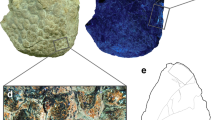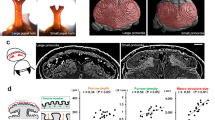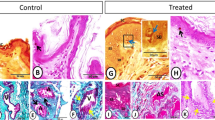Abstract
THIS investigation was designed to clarify some confusing statements concerning rhinoceros horn which appear in the literature : for example, that it appears to be composed of matted hair1,2; that it is formed wholly of keratin produced by stratum corneum3; that it is composed of coarse keratin fibres cemented together4. The present investigation has confirmed that rhinoceros horn has a tubular (filamentous) structure comparable with that described in other horn by Trautmann and Fiebiger5 quoting Nickel6. This structure of rhinoceros horn has already been briefly recognized by Boas7, whose term for the tubules was canals, by Makinson8, who described the structure as cylindrical, and by Le Gros Clark9. But, as horn tubules (filaments) in general form over dermal papillae, the implication of Le Gros Clark that rhinoceros horn is unique in this respect is not correct. Dove10 said that rhinoceros horn was similar to that in cattle. During the present work it has not been possible to demonstrate horn, tubules in either sheep or cattle horns, in which, according to Trautmann and Fiebiger, the tubular structure is not marked; in addition to those in rhinoceros horn, tubules have been observed in the hoof. In the present work the term filament is preferred to the term tubule (which suggests a hollow structure) and to the term fibre (which suggests equivalence to hair).
This is a preview of subscription content, access via your institution
Access options
Subscribe to this journal
Receive 51 print issues and online access
$199.00 per year
only $3.90 per issue
Buy this article
- Purchase on Springer Link
- Instant access to full article PDF
Prices may be subject to local taxes which are calculated during checkout
Similar content being viewed by others
References
Beddard, F. E., Cambridge Natural History, 10, 253 (Macmillan, London, 1902).
Anthony, H. E., Bull. N.Y. Zool. Soc., 31, 179 (1928).
Neal, H. V., and Rand, H. W., Chordate Anatomy, 118 (Blakiston, Philadelphia, 1939).
Montagna, W., Comparative Anatomy, 596 (Wiley, New York, 1959).
Trautmann, A., and Fiebiger, J., Fundamentals of the Histology of Domestic Animals, translated from the ninth German ed., 1949, 360 (Baillière, Tindall and Cox, London, 1960).
Nickel, R., Deutsch. tierarztl. Wschr., 46, 449 (1938).
Boas, J. E. V., in Handbuch de Vergleichenden Anatomie der Wirbeltiere, edit. by Bolk, Goeppert, Kallius and Lubosch, 1, 545 (Urban and Schwarzlaberg, Berlin, 1931).
Makinson, K. Rachel, Austral. J. Biol. Sci., 7, 336 (1954).
Le Gros Clark, W. E., The Tissues of the Body (Clarendon Press, Oxford, 1945).
Dove, W. F., J. Exp. Zool., 69, 347 (1935).
Ryder, M. L., Proc. Roy. Soc. Edin., B, 67, 65 (1958).
Appleyard, H. M., and Dymoke, C. M., J. Text. Inst., 45, T, 480 (1954).
Author information
Authors and Affiliations
Rights and permissions
About this article
Cite this article
RYDER, M. Structure of Rhinoceros Horn. Nature 193, 1199–1201 (1962). https://doi.org/10.1038/1931199a0
Issue Date:
DOI: https://doi.org/10.1038/1931199a0
This article is cited by
-
Creating artificial Rhino Horns from Horse Hair
Scientific Reports (2019)
-
Molecular Orientation of Some Keratins
Nature (1962)
Comments
By submitting a comment you agree to abide by our Terms and Community Guidelines. If you find something abusive or that does not comply with our terms or guidelines please flag it as inappropriate.



